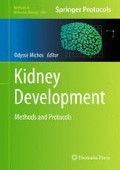Abstract
Organotypic culture is an invaluable technique that allows researchers with the tool to analyze a tissue development in an isolated and well-defined environment. This technique also permits one to study the roles of different signaling systems/signaling molecules and to take advantage of the modern real-time imaging techniques, including confocal microscopy. With great success, our lab has used organotypic culture of the urogenital tract (UGT) to study growth and extension of the mesonephric (Wolffian) duct and its cloaca connection, ureter maturation, and bladder urothelium development (Batourina et al. Nat Genet 32:109, 2002; Batourina et al. Nat Genet 37:1082, 2005; Mendelsohn Organogenesis 5:306, 2009).
Access this chapter
Tax calculation will be finalised at checkout
Purchases are for personal use only
References
Batourina E, Choi C, Paragas N et al (2002) Distal ureter morphogenesis depends on epithelial cell remodeling mediated by vitamin A and Ret. Nat Genet 32:109
Batourina E, Tsai S, Lambert S et al (2005) Apoptosis induced by vitamin A signaling is crucial for connecting the ureters to the bladder. Nat Genet 37:1082
Mendelsohn C (2009) Using mouse models to understand normal and abnormal urogenital tract development. Organogenesis 5:306
Scott JE (1987) Fetal ureteric reflux. Br J Urol 59:291
Bernstein GT, Mandell J, Lebowitz RL et al (1988) Ureteropelvic junction obstruction in the neonate. J Urol 140:1216
Kaefer M, Tobin MS, Hendren WH et al (1997) Continent urinary diversion: the Children’s Hospital experience. J Urol 157:1394
Staack A, Hayward SW, Baskin LS, Cunha GR (2005) Molecular, cellular and developmental biology of urothelium as a basis of bladder regeneration. Differentiation 73:121
Baskin LS, Hayward SW, Sutherland RA et al (1997) Cellular signaling in the bladder. Front Biosci 2:d592
Seifert AW, Harfe BD, Cohn MJ (2008) Cell lineage analysis demonstrates an endodermal origin of the distal urethra and perineum. Dev Biol 318:143
Lewis SA (2000) Everything you wanted to know about the bladder epithelium but were afraid to ask. Am J Physiol Renal Physiol 278:F867
Author information
Authors and Affiliations
Corresponding author
Editor information
Editors and Affiliations
Rights and permissions
Copyright information
© 2012 Springer Science+Business Media, LLC
About this protocol
Cite this protocol
Batourina, E., Gandhi, D., Mendelsohn, C.L., Molotkov, A. (2012). Organotypic Culture of the Urogenital Tract. In: Michos, O. (eds) Kidney Development. Methods in Molecular Biology™, vol 886. Humana Press, Totowa, NJ. https://doi.org/10.1007/978-1-61779-851-1_5
Download citation
DOI: https://doi.org/10.1007/978-1-61779-851-1_5
Published:
Publisher Name: Humana Press, Totowa, NJ
Print ISBN: 978-1-61779-850-4
Online ISBN: 978-1-61779-851-1
eBook Packages: Springer Protocols

